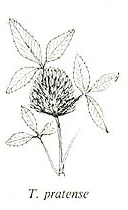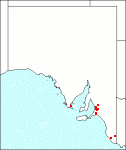|
Trifolium pratense
Citation:
L., Sp. Pl. 768 (1753).
Synonymy: Not Applicable Common name: Red clover.
Description:
Robust perennial with erect or decumbent more or less hairy to villous stems 5-100 but usually 20-40 cm long; leaves on petioles 1-10 (or more) cm long but progressively shorter up the stem so that little or no petiole separates the stipules from the leaflets of the uppermost leaves; leaflets subsessile, petiolules subequal, elliptic to obovate or nearly orbicular, 1.5-5 cm long, entire or obscurely denticulate, often glabrescent above, hairy below; stipules large, basal part fused, ovate, heavily parallel-veined in green, 10-20-mm long, triangular above and abruptly contracted into a setaceous usually ciliate point, upper stipules very wide.
Flowers numerous (up to 100 or more) in large globose or ovoid heads 20-40 mm across and solitary or paired, usually sessile and with an involucre of stipules of diminished leaves; calyx tube obconical, c. 2 mm long, 10-veined, usually appressed-hairy; teeth unequal, triangular with a filiform apex, straight, ciliate, separated by broad sinuses, lowest lobe at least twice as long as the tube, the other 4 about as long as the tube; throat of the calyx tube open, with an annular hairy thickening; corolla 12-15 mm long, usually reddish-purple or pink (in S.Aust.) rarely cream or white, to 2 times as long as the lowest calyx tooth; standard notched.
Pod with a thickened apex, 1- or rarely 2-seeded; seed cordate, c. 1.5 mm, brown, smooth.

|
|
Image source: fig. 353L in Jessop J.P. & Toelken H.R. (Ed.) 1986. Flora of South Australia (4th edn).
|
Published illustration:
Hegi (1924) Illustrierte Flora von Mittel Europa 4, 3:t. 162.
|
|
Distribution:
|
W.Aust.; ?Qld; N.S.W.; Vic.; Tas. Of European origin, widely grown as a fodder plant and naturalised through-out the world.
|
Conservation status:
naturalised
Flowering time: Nov. — March.
|

SA Distribution Map based
on current data relating to
specimens held in the
State Herbarium of South Australia
|
Biology:
No text
Taxonomic notes:
Extremely variable in both the wild and cultivated state in habit, stature, indumentum, size and shape of leaflets and size and colour of flowers. Many ecologically specialised wild populations are locally distinct in Europe from where accidental or intentional introduction was made to S. Aust. and the origin of these plants is unclear. The 5 varieties recorded by Coorobe (1968) Flora Europaea 2:168, can not be distinguished here on our specimens. The non-rhizomatous habit, the stipels and the calyx afford the best means of identification.
Author:
Not yet available
|

